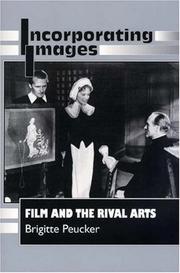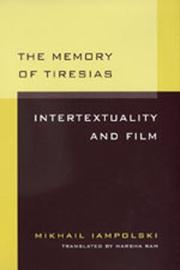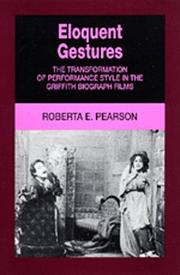| Listing 1 - 3 of 3 |
Sort by
|

ISBN: 140086402X 0691600678 0691002819 9781400864027 Year: 2014 Publisher: Princeton Princeton University Press
Abstract | Keywords | Export | Availability | Bookmark
 Loading...
Loading...Choose an application
- Reference Manager
- EndNote
- RefWorks (Direct export to RefWorks)
Film, a latecomer to the realm of artistic media, alludes to, absorbs, and undermines the discourses of the other arts--literature and painting especially--in order to carve out a position for itself among them. Exposing the anxiety in film's relation to its rival arts, Brigitte Peucker analyzes central issues involved in generic boundary crossing as they pertain to film and situates them in a theoretical framework. The figure of the human body takes center stage in Peucker's innovative study, for it is through this figure that the conjunction of literary and painterly discourses persistently articulates itself. It is through the human body, too, that film's consciousness of itself as a hybrid text and as a "machine for simulation" makes itself deeply felt.In films ranging from Weimar cinema through Griffith, Hitchcock, and Greenaway, Peucker probes issues in aesthetics problematized by Diderot and Kleist, among others. She argues that the introduction of movement into visual representation occasioned by film brings with it an underlying tension suggestive of castration and death. Peucker goes on to demonstrate how the encounter between narrative and image is both gendered and sexualized, rendering film a "monstrous" hybrid. In a final section, she explores in specific cinematic texts the permeable boundary between the real and representation, suggesting how effects such as tableau vivant and trompe l'oeil figure sexuality and death.Originally published in 1995.The Princeton Legacy Library uses the latest print-on-demand technology to again make available previously out-of-print books from the distinguished backlist of Princeton University Press. These editions preserve the original texts of these important books while presenting them in durable paperback and hardcover editions. The goal of the Princeton Legacy Library is to vastly increase access to the rich scholarly heritage found in the thousands of books published by Princeton University Press since its founding in 1905.
#SBIB:309H1321 --- Brigitte Peucker --- film en literatuur --- Wiene Robert --- film en feminisme --- Films met een amusementsfunctie en/of esthetische functie: algemeen --- Motion pictures and the arts --- Motion pictures --- 791.41 --- film --- film en psychoanalyse --- film en schilderkunst --- filmtheorie --- gender studies --- Greenaway Peter --- Griffith David Wark --- Hitchcock Alfred --- Lang Fritz --- 791.43 --- 791.43 Filmkunst. Films. Cinema --- Filmkunst. Films. Cinema --- Aesthetics --- Arts and motion pictures --- Moving-pictures and the arts --- Arts --- Motion pictures and the arts. --- Aesthetics. --- PERFORMING ARTS / Film & Video / History & Criticism.

ISBN: 0520085299 0520085302 0520914724 0585228442 9780520914728 9780585228440 9780520085299 9780520085305 Year: 1998 Publisher: Berkeley : University of California Press,
Abstract | Keywords | Export | Availability | Bookmark
 Loading...
Loading...Choose an application
- Reference Manager
- EndNote
- RefWorks (Direct export to RefWorks)
The concept of intertextuality has proven of inestimable value in recent attempts to understand the nature of literature and its relation to other systems of cultural meaning. In The Memory of Tiresias, Mikhail Iamposlki presents the first sustained attempt to develop a theory of cinematic intertextuality.Building on the insights of semiotics and contemporary film theory, Iampolski defines cinema as a chain of transparent, mimetic fragments intermixed with "ations he calls "textual anomalies." These challenge the normalization of meaning and seek to open reading out onto the unlimited field of cultural history, which is understood in texts as a semiotically active extract, already inscribed.Quotations obstruct mimesis and are consequently transformed in the process of semiosis, an operation that Iampolski defines as reading in an aura of enigma. In a series of brilliant analyses of films by D.W. Griffith, Sergei Eisenstein, and Luis Buñuel, he presents different strategies of intertextual reading in their work. His book suggests the continuing centrality of semiotic analysis and is certain to interest film historians and theorists, as well as readers in cultural and literary studies.
Literary semiotics --- Film --- Motion pictures. --- Intertextuality. --- Motion pictures --- Intertextuality --- Music, Dance, Drama & Film --- 82:791.43 --- film --- filmtheorie --- intertekstualiteit --- semiotiek --- Griffith David Wark --- Eisenstein Sergei --- Bunuel Luis --- Cendrars Blaise --- Léger Fernand --- Dali Salvador --- Tynianov Iurii --- 791.41 --- 82:791.43 Literatuur en film --- Literatuur en film --- Cinéma --- Théorie du cinéma --- Intertextualité --- Récit filmique --- Esthétique --- Cinema --- Feature films --- Films --- Movies --- Moving-pictures --- Audio-visual materials --- Mass media --- Performing arts --- Criticism --- Semiotics --- Influence (Literary, artistic, etc.) --- History and criticism --- Intertextualité. --- Théorie du cinéma. --- Récit filmique. --- Esthétique.

ISBN: 0585299404 0520911040 9780520911048 9780585299402 0520073657 9780520073654 0520073665 9780520073661 Year: 1992 Publisher: Berkeley University of California Press
Abstract | Keywords | Export | Availability | Bookmark
 Loading...
Loading...Choose an application
- Reference Manager
- EndNote
- RefWorks (Direct export to RefWorks)
Between 1908 and 1913, D. W. Griffith played a key role in the reformulating of film's narrative techniques, thus contributing to the creation of what we now think of as the classical Hollywood cinema. This book is the only extensive treatment of a critical period in the history of film acting: the emergence of the realistic "verisimilar" style in Griffith's biograph films. Roberta Pearson shows how Griffith gradually abandoned the deliberately affected "histrionic" acting style derived from the nineteenth-century stage. No longer did actors mime distress by raising their arms to heaven or clutching their heads--a subtle facial expression, a slight change in posture would convey a character's extreme emotions instead. Pearson makes detailed comparisons of certain Biograph films and brings a freshness to her analysis by closely examining contemporary journalistic writing, acting manuals, and the recollections of actors of the time. Her work is important for anyone interested in early cinema and performance, and it will enliven the study of American cultural history and mass communications.
Silent films --- Motion picture acting. --- Movement (Acting) --- Motion picture acting --- Music, Dance, Drama & Film --- Film --- Film acting --- Moving-picture acting --- Acting --- Movement on the stage --- Moving pictures, Silent --- Silent motion pictures --- Motion pictures --- History. --- History and criticism --- Griffith, D. W. --- Griffit, Dėvid Uork, --- Griffith, David Wark, --- Warwick, Grenville, --- Criticism and interpretation. --- Biograph Company. --- AB --- American Mutoscope and Biograph Company --- Protective Amusement Company --- Klaw & Erlanger --- History and criticism. --- acting manuals. --- actors. --- american cultural history. --- american director. --- biography films. --- birth of a nation. --- cinema. --- classical hollywood cinema. --- controversy. --- dw griffith. --- early cinema. --- extreme emotion. --- feature length movie. --- film acting. --- film and television. --- film theory. --- henry d walthall. --- hollywood. --- mass communication. --- movie theory. --- movies. --- narrative technique. --- performance style. --- performing arts. --- realistic film. --- theatrical heritage. --- trade press discourse. --- united states of america. --- verisimilar.
| Listing 1 - 3 of 3 |
Sort by
|

 Search
Search Feedback
Feedback About
About Help
Help News
News